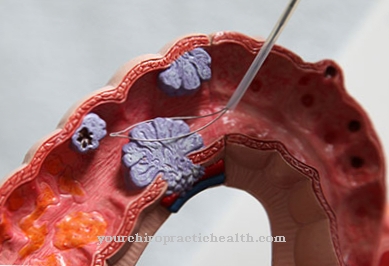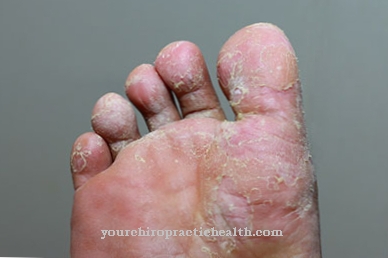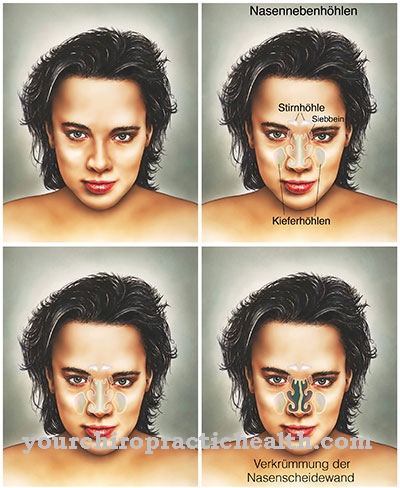At the Duane Syndrome it is a seldom occurring eye muscle paralysis that is congenital. The exact causes of the disease have not yet been established.
What is Duane Syndrome?

© bilderzwerg - stock.adobe.com
The Duane Syndrome is also under the names congenital retraction syndrome according to Stilling-Türk-Duane, Stilling-Türk-Duane syndrome or Retraction syndrome known. What is meant is a congenital (innate) eye muscle paralysis, which occurs very rarely. The disease was named after the ophthalmologists Alexander Duane, Jakob Stilling and Siegmund Türk, who described it between 1887 and 1905.
Duane syndrome accounts for around one percent of cases of strabismus. Since there are different symptom complexes in Duane syndrome, the disease is divided into different types. The syndrome only affects one eye in around 80 percent of those affected. With a disease rate of around 60 percent, girls are particularly affected by eye muscle paralysis. Around 70 percent of all sick people have no other health disorders.
causes
The exact cause of Duane syndrome is still unclear. Some doctors suspect damage to the VI. Cranial nerve that is already congenital. In addition, the lateral rectus muscle, which is responsible for the branches of the oculomotor nerve, is incorrectly innervated. Furthermore, scientists assume hereditary factors. If the musculus rectus medialis of the diseased eye is tense, the false innervation with simultaneous activity of the musculus rectus lateralis results, so to speak, in a restraining effect.
Typical for Duane syndrome is its extensive range of variation. This is caused by the different size ratio between the three parts of the lateral rectus muscle. These are the section that is normally innervated by the abducens nerve, the area that the oculomotor nerve is not innervating, and the fibrotic region that is not innervated at all. Furthermore, special features result from the fact whether high-threshold or low-threshold neurons grow in.
You can find your medication here
➔ Medicines for eye infectionsSymptoms, ailments & signs
The severity of Duane syndrome varies greatly. For this reason, medicine divides the disease into three types from I to III. Duane syndrome type I is when there is a slight internal squint and slightly reduced adduction when looking straight ahead. Abduction is only possible up to the midline. When trying to perform an adduction, there is a slight narrowing of the eyelid gap, which is accompanied by a retraction. About 80 percent of all those affected suffer from Duane syndrome type I.
Duane syndrome type II is a considerably more pronounced adduction. Further symptoms are a sharp narrowing of the eyelid and a retraction when attempting adduction. The abduction exists only to a limited extent and can be carried out above the midline. During adduction, the eye can be lowered or raised. In Duane syndrome type III there is a considerable limitation of adduction and abduction. In addition, retraction can occur without adduction.
When the patient tries to move the eyeball towards the nose, which is known as adduction, the eyelids narrow. At the same time, the eyeball is retracted into the eye socket. Depending on the extent of the disease, movements of the eye towards the temple (abduction) can only be made to a limited extent. The extent of the restrictions depends on the stage of the disease.
If the patient looks straight ahead, a clear squint (strabismus) can be noticed. This often leads to a corresponding forced posture of the head. In some patients further malformations of the eyes, ears, skeleton, nerves or kidneys are possible. Sometimes even heart abnormalities occur.
diagnosis
The Duane syndrome is diagnosed in an eye clinic or a specialist department of a hospital. Various tests are carried out with the aim of distinguishing Duane's syndrome from other forms of strabismus.
These primarily include electromyography, the double image schemes and precise motility analyzes. It is also important to rule out palsy of the abdomen (paralysis of the abducens nerve). Duane syndrome is considered difficult to cure. In some cases, a squint operation can improve the situation.
Complications
The movement disorders of the eyes that occur with Duane syndrome are divided into types I, II and III. Slight complications occur in type I, as the patients show only a slight inward squint when looking straight ahead. The eyeball of the affected eye moves clearly towards the nose, narrowing the eyelid and pulling the eyeball back into the eye socket.
In people with type II and type III syndrome, the disturbances in eye mobility are much more pronounced. In type II, the patient can raise or lower the eyes, the retraction of the eyeball into the orbit occurs when the eyeball is moved beyond the midline, while the squint is less pronounced. In type III, there are considerable restrictions in eye mobility and severe internal squint.
The movement of the eyeball towards the temple and thus a panoramic view are only possible to a limited extent. Squinting creates an obsessive head posture in many of those affected. Other potential complications are malformations of the ears, eyes, skeleton, nerves and kidneys.
In severe disease, which is mostly associated with type III, abnormalities of the heart can also occur. Surgical interventions and visual aids are conceivable, but treatment is difficult. A complete elimination of the complex malformations is not possible in most cases.
When should you go to the doctor?
Parents who notice abnormal squinting, narrowing of the eyelid gap, and other signs of Duane syndrome in their child should seek medical advice. If further malformations are noticed in the face or in the limbs, everything indicates a serious condition, which must be clarified immediately and treated if necessary. If the child complains of a heart attack or kidney pain, it is best to contact the emergency medical service. Even with unspecific symptoms, a clarification by a pediatrician or a specialist is always useful.
In general: Unusual symptoms and complaints must be clarified quickly. If there is already a suspicion of an illness, the pediatrician should be called in immediately if there are serious complications. The retraction syndrome must always be clarified and treated in order to rule out a severe course. In addition to the pediatrician or family doctor, a specialist in hereditary diseases or an ophthalmologist can also be called in. A diagnosed syndrome should be treated at a specialist genetic disease clinic.
Doctors & therapists in your area
Treatment & Therapy
Because Duane syndrome is a rare and complex disease, treatment is difficult. Sometimes a squint operation can be useful. The aim is to shift binocular simple vision to a straight head posture in order to correct the previous forced posture of the head so that this no longer occurs in the future. During the procedure, the corresponding eye muscles are carefully repositioned.
Either the affected tendon or the muscle is shortened while the original muscle attachment remains. In this way, increasing the retraction can be avoided. The success rate of the operation is around 80 percent and leads to an improvement in optical conditions. In principle, it can be carried out at any age, but only takes place when the affected child can walk.
In addition, the body's visual system takes three to four years to fully develop. Furthermore, from a certain age, communication with the patient is easier. The type of operation ultimately depends on what stage of the syndrome the child is suffering from. According to the recommendations of ophthalmologists, however, surgery should only be performed on children if they have problems with their upright appearance. In addition to a surgical procedure, some aids can also make the child's life easier. These include prisms on the glasses or special seats in the school.
Outlook & forecast
Duane syndrome can only be treated with symptomatic treatment; causal treatment is not possible here. Likewise, there is no self-healing, so that those affected are dependent on treatment in any case. If the Duane syndrome is not treated, the various malformations of the internal organs remain and usually lead to a reduced life expectancy for the person affected.
Treatment is based on the exact malformations and symptoms. These can be limited relatively well through various surgical interventions. Operations on the eyes in particular are necessary to improve the patient's quality of life again. However, the patients are still dependent on glasses. Malformations of the internal organs are also corrected if a correction is necessary. The further course depends very much on the exact form of these malformations.
Without treatment, Duane syndrome can lead to severe psychological complaints, which can occur not only in the person concerned, but also in the relatives. Self-help measures can treat many restrictions and thereby improve the patient's quality of life.
You can find your medication here
➔ Medicines for eye infectionsprevention
Duane syndrome is one of the congenital diseases. For this reason there is no way to effectively prevent the suffering.
Aftercare
With Duane syndrome, there are hardly any aftercare options available to those affected. The patient is primarily dependent on direct treatment by a doctor. Above all, an early diagnosis and early treatment have a very positive effect on the further course of this complaint and can prevent further complications or, in the worst case, complete blindness.
The earlier the disease is recognized, the better the further course will usually be. In most cases, patients with this disease are dependent on surgery. This intervention should be carried out very early to guarantee normal development of the child. Furthermore, the person affected should rest after such an operation and take care of his body.
Exertion or other stressful activities and activities are to be avoided in order not to unnecessarily burden the body. In many cases, those affected also need the support of their parents and their own families in order to cope with everyday life. Loving and intensive care has a positive effect on the course of the disease. As a rule, Duane syndrome does not reduce the patient's life expectancy.
You can do that yourself
Duane syndrome always requires medical treatment. In addition, different measures can be taken to alleviate the individual symptoms.
Regular eye training is recommended to accompany the squint operation. In most cases, the affected child also has to wear a visual aid. Aids such as special seats in the school can also make life easier for the child. The exact steps to be taken here must be discussed with a doctor. Parents who notice changes in personality in their child should speak to them immediately.
Often the cosmetic abnormalities lead to teasing and bullying and the child withdraws from social life. It is advisable to intervene early and, if necessary, speak to the teachers. A visit to a therapist is recommended for severe mental illness. In principle, parents should inform their child about the disease and, as far as possible, explain the symptoms and the possible consequences.
If the visual disturbances persist despite all the measures taken or if they recur after a period of symptom-free treatment, the responsible doctor must be spoken to again.



.jpg)























